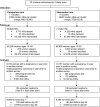Effect on Neonatal Mortality of Newborn Infection Management at Health Posts When Referral Is Not Possible: A Cluster-Randomized Trial in Rural Ethiopia
- PMID: 28611102
- PMCID: PMC5487084
- DOI: 10.9745/GHSP-D-16-00312
Effect on Neonatal Mortality of Newborn Infection Management at Health Posts When Referral Is Not Possible: A Cluster-Randomized Trial in Rural Ethiopia
Abstract
Background: The World Health Organization recently provided guidelines for outpatient treatment of possible severe bacterial infections (PSBI) in young infants, when referral to hospital is not feasible. This study evaluated newborn infection treatment at the most peripheral level of the health system in rural Ethiopia.
Methods: We performed a cluster-randomized trial in 22 geographical clusters (11 allocated to intervention, 11 to control). In both arms, volunteers and government-employed Health Extension Workers (HEWs) conducted home visits to pregnant and newly delivered mothers; assessed newborns; and counseled caregivers on prevention of newborn illness, danger signs, and care seeking. Volunteers referred sick newborns to health posts for further assessment; HEWs referred newborns with PSBI signs to health centers. In the intervention arm only, between July 2011 and June 2013, HEWs treated newborns with PSBI with intramuscular gentamicin and oral amoxicillin for 7 days at health posts when referral to health centers was not possible or acceptable to caregivers. Intervention communities were informed of treatment availability at health posts to encourage care seeking. Masking was not feasible. The primary outcome was all-cause mortality of newborns 2-27 days after birth, measured by household survey data. Baseline data were collected between June 2008 and May 2009; endline data, between February 2013 and June 2013. We sought to detect a 33% mortality reduction. Analysis was by intention to treat. (ClinicalTrials.gov registry: NCT00743691).
Results: Of 1,011 sick newborns presenting at intervention health posts, 576 (57%) were identified by HEWs as having at least 1 PSBI sign; 90% refused referral and were treated at the health post, with at least 79% completing the antibiotic regimen. Estimated treatment coverage at health posts was in the region of 50%. Post-day 1 neonatal mortality declined more in the intervention arm (17.9 deaths per 1,000 live births at baseline vs. 9.4 per 1,000 at endline) than the comparison arm (14.4 per 1,000 vs. 11.2 per 1,000, respectively). After adjusting for baseline mortality and region, the estimated post-day 1 mortality risk ratio was 0.83, but the result was not statistically significant (95% confidence interval, 0.55 to 1.24; P=.33).
Interpretation: When referral to higher levels of care is not possible, HEWs can deliver outpatient antibiotic treatment of newborns with PSBI, but estimated treatment coverage in a rural Ethiopian setting was only around 50%. While our data suggest a mortality reduction consistent with that which might be expected at this level of coverage, they do not provide conclusive results.
© Hailegebriel et al.
Figures




Comment in
-
Reducing Sepsis Deaths in Newborns Through Home Visitation and Active Case Detection: Is it Realistic?Glob Health Sci Pract. 2017 Jun 27;5(2):177-179. doi: 10.9745/GHSP-D-17-00201. Print 2017 Jun 27. Glob Health Sci Pract. 2017. PMID: 28611101 Free PMC article.
References
-
- Bhutta ZA, Das JK, Bahl R, et al. ; Lancet Newborn Interventions Review Group; Lancet Every Newborn Study Group. Can available interventions end preventable deaths in mothers, newborn babies, and stillbirths, and at what cost? Lancet. 2014; 384(9940):347–370. 10.1016/S0140-6736(14)60792-3. - DOI - PubMed
-
- Friberg IK, Kinney MV, Lawn JE, et al. ; Science in Action: Saving the lives of Africa's Mothers, Newborns, and Children working group. Sub-Saharan Africa's mothers, newborns, and children: how many lives could be saved with targeted health interventions? PLoS Med. 2010; 7(6):e1000295. 10.1371/journal.pmed.1000295. - DOI - PMC - PubMed
-
- Baqui AH, El-Arifeen S, Darmstadt GL, et al. ; Projahnmo Study Group. Effect of community-based newborn-care intervention package implemented through two service-delivery strategies in Sylhet district, Bangladesh: a cluster-randomised controlled trial. Lancet. 2008; 371(9628):1936–1944. 10.1016/S0140-6736(08)60835-1. - DOI - PubMed
Publication types
MeSH terms
Substances
Associated data
Grants and funding
LinkOut - more resources
Full Text Sources
Other Literature Sources
Medical
